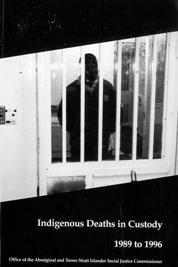Indigenous Deaths in Custody: Introduction to Analysis of Case Studies
Part C - Profiles Analysis
Chapter 5
Summary
IntroductionPart C of the Report examines implementation of Royal Commission recommendations in light of the case studies. Recommendations are grouped into five chapters and areas: 6, Policing Practices; 7, Courts and Imprisonment; 8, Custodial Conditions; 9, Juveniles; and 10, Post-death Investigations. As noted in chapter 1, these chapters contain schedules listing the frequency of breaches of recommendations and a discussion of case studies and related material under each Royal Commission recommendation. Overview of Breaches of RecommendationsTable 5.1 provides a summary of the breaches of recommendations across the five areas. Breaches are only listed for 75 deaths. Breaches of recommendations were not recorded in 21 deaths, as the coronial inquest has not been completed at the time of publication or there was insufficient information available regarding the circumstances of the death. Excluding recommendations concerning post-death investigations, coroners detected 47 per cent of the listed breaches of recommendations. The Office of the Social Justice Commissioner detected the majority of breaches concerning police practices, courts and imprisonment and juveniles. Coroners were more likely to detect breaches of recommendations concerning custodial conditions. As will be discussed in chapter 10, coroners should expand the scope of their inquiry to examine arresting and sentencing practices which led to the incarceration of the deceased. The breaches of the recommendations were broken into two periods to determine whether there has been a positive improvement over time since the Royal Commission. The first 37 of the 75 investigated deaths represent period I (31 May 1989 - 5 March 1992). The next 38 deaths represent period II (25 March 1992 - 13 January 1996). Table 5.2 illustrates that there has not been a reduction in the average number of recommendation breached in the second period: an average of 8.3 recommendations were breached in the first period and 8.6 were breached in the second period.
Table 5.1 also breaks down breaches of recommendations by state and territory. The average number of recommendations breached are shown in Table 5.2 and Figure 5.1. There was an average of 8.3 recommendations breached in each death in Australia. The highest average number of breaches were in the states of Queensland (13.6) and Western Australia (8.9).
Figure 5.1 Average Breach of Recommendations by State/Territory
|
Contents Previous Next  |
|||||||||||||||||||||||||||||||||||||||||||||||||||||||||||||||||||||||||||||||||||||||||||||||||||||||||||||||||||||||||||||||||||||||||||||||||||||||||||||||||||||||||||||||||||||||||||||||||||

